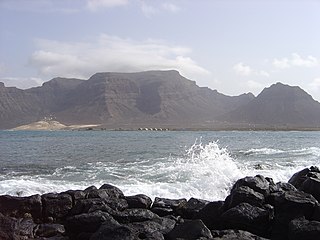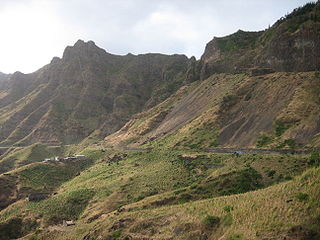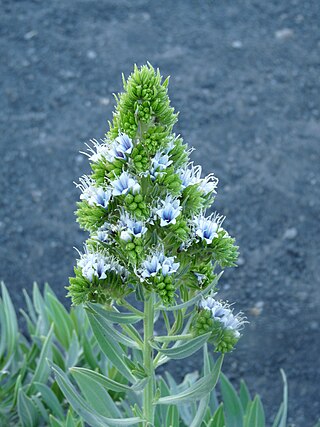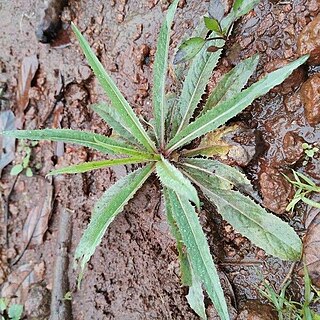
Cape Verde is a group of arid Atlantic islands which are home to distinct communities of plants, birds, and reptiles. The islands constitute the unique Cape Verde Islands dry forests ecoregion, according to the World Wildlife Fund.

Monte Verde is a mountain in the eastern part of the island of São Vicente, Cape Verde. At 744 m elevation, it is the island's highest point. The mountain is located 6 km (4 mi) east of the city centre of Mindelo.

Tope de Coroa is a mountain on the island of Santo Antão's, Cape Verde, Africa. At 1,979 m elevation, it is the highest point of the island. It is in the western part of the island, 25 km west of the island capital Porto Novo. The mountain is entirely of volcanic origin. The area is the source of several streams including Ribeira de Monte Trigo which flows westward to Monte Trigo.

Serra Malagueta is a mountain range located in the northern part of the island of Santiago, Cape Verde. At 1064 m elevation, it is highest point of northern Santiago. The mountain range is protected as the Serra Malagueta Natural Park, that was established on February 24, 2005 and covers 774 hectares. The natural park is situated in the municipalities Tarrafal, São Miguel and Santa Catarina. The summit is in São Miguel, south of the Ribeira Principal valley. The Serra Malagueta formation is of volcanic origin, and was formed between 2.9 and 2.4 million years ago.

Umbilicus schmidtii is a flowering plant in the family Crassulaceae. The species is endemic to Cape Verde. It is listed as endangered by the IUCN.
Exormotheca is a group of liverworts in the family Exormothecaceae. It was described as a genus in 1870.
- Exormotheca bischleraeFuruki & Higuchi - China
- Exormotheca bulbigena Bornefeld, O.H. Volk & R. Wolf - Namibia
- Exormotheca bullosa(Stephani) K. Müller - Portugal
- Exormotheca ceylonensisMeijer - Sri Lanka
- Exormotheca holstiiSteph. - Namibia, South Africa
- Exormotheca martins-loussaoae Sim-Sim, A.Martins, J.Patiño & C.A.Garcia - Cape Verde
- Exormotheca pustulosaMitt. - Oman, Yemen, Saudi Arabia, United Arab Emirates, St. Helena, Mexico, Tanzania, Canary Islands, Spain, France, Portugal
- Exormotheca welwitschiiSteph. - Algarve

Artemisia gorgonum is a species of flowering plants of the family Asteraceae, endemic to Cape Verde. Its local name is losna or lasna. The plant plays a role in traditional medicine.

Euphorbia tuckeyana is a species of flowering plants of the family Euphorbiaceae. The species is endemic to Cape Verde. The species is named after James Hingston Tuckey. Its local name is tortolho. The plants are used for tanning hides. As most other succulent members of the genus Euphorbia, its trade is regulated under Appendix II of CITES.

Echium hypertropicum is a species of flowering plants of the family Boraginaceae. The species is endemic to Cape Verde. It is listed as an endangered plant by the IUCN.

Echium stenosiphon is a plant species of the family Boraginaceae. The species is endemic to Cape Verde. Its local name is língua-de-vaca, a name that may also refer to the related species Echium vulcanorum and Echium hypertropicum. The plant is used in traditional medicinal for a cough syrup.
Micromeria forbesii is a species of flowering plants of the genus Micromeria. The species is endemic to Cape Verde. It is listed as endangered by the IUCN. It was first described by George Bentham in 1834. Its local name is erva-cidreira, or cidreirinha. In traditional medicine, it is used as an infusion for the treatment of indigestion, diarrhea, cough and to stimulate labour.

Echium vulcanorum is a species of flowering plants of the family Boraginaceae. The species is endemic to Cape Verde. It is listed as an endangered plant by the IUCN. The species was first described in 1935 by Auguste Chevalier. Its local name is língua-de-vaca, a name that may also refer to the related species Echium hypertropicum and Echium stenosiphon. The oil of its seeds contains γ-linolenic acid, and is used for medicinal and dietary purposes.
Sonchus daltonii is a species of flowering plants of the family Asteraceae. The species is endemic to Cape Verde. It is listed as endangered by the IUCN. The genus was named by Philip Barker Webb in 1849. Its local name is coroa-de-rei.
Conyza feae is a species of flowering plant that belongs to the family Asteraceae. The species is endemic to Cape Verde. It is listed as an endangered plant by the IUCN. First described as Nidorella feae, it was placed in the genus Conyza by Hiram Wild in 1969. The specific name feae refers to the Italian naturalist Leonardo Fea. Its local name is losna-brabo or losna-bravo. The plant plays a role in traditional medicine.
Moroços Natural Park, in the middle of the island of Santo Antão, is one of ten "natural parks" in Cape Verde. The protected area is 8.18 km2 (3.16 sq mi). It covers 7.46 km2 (2.88 sq mi) of the municipality of Ribeira Grande, and 0.71 km2 (0.27 sq mi) of Porto Novo.

Asteriscus smithii is a species of flowering plants of the family Asteraceae. The species is endemic to the island of São Nicolau, Cape Verde. It is listed as critically endangered due to its very restricted area of occupancy and its low population size. Its local name is macela-de-gordo.
Asteriscus daltonii is a species of flowering plants of the family Asteraceae. The species is endemic to Cape Verde. Its local name is macela. It is listed as near threatened by the IUCN.
Launaea gorgadensis is a species of flowering plants of the family Asteraceae. The species is endemic to Cape Verde. It is listed as a critically endangered plant by the IUCN.

Launaea picridioides is a species of flowering plants of the family Asteraceae. The species is endemic to Cape Verde. It is listed as a vulnerable species by the IUCN.
Tolpis farinulosa is a species of flowering plants of the family Asteraceae. The species is endemic to Cape Verde. It is listed as endangered by the IUCN. Its local name is mato-branco, a name that may also refer to the species Phagnalon melanoleucum and Verbascum cystolithicum.











